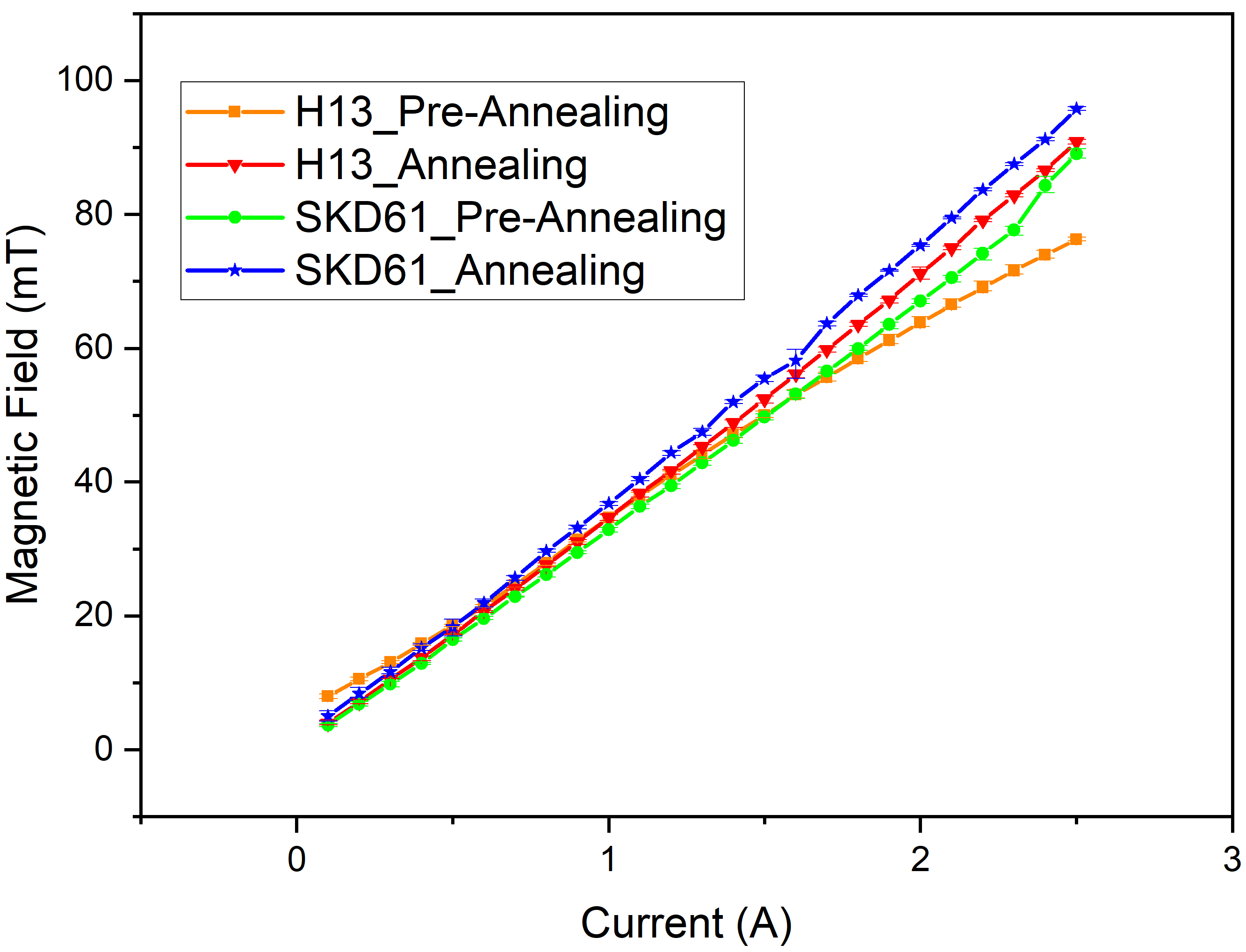Magnetic and electrical properties of H13 tool steel by bound metal deposition 3D printing: Annealed and non-annealed
Author affiliations
DOI:
https://doi.org/10.15625/0866-7136/22285Keywords:
bound metal deposition 3D printing, magnetic properties, electrical properties, tool steels, H13 tool steel, SKD61 tool steelAbstract
In recent years, a new additive manufacturing process called bound metal deposition has emerged and advanced dramatically. While most studies have concentrated mainly on the mechanical properties of 17-4PH stainless steel, with some focus on tool steels, there remains a gap in studies exploring a wider variety of materials and other applications. This study aims to address this by using another type of steel, namely H13 tool steel. The material is employed to form 3D-printed samples through the bound metal deposition process. Material characterizations of magnetic and electrical properties are subsequently performed on the printed samples. In addition, the impact of a thermal annealing post-process is studied to better understand its effects on the material properties. Underlying mechanisms responsible for changes in material properties are proposed to provide valuable insights into different treatments that influence the behavior of the investigated materials. Additional samples of conventional hot-rolled SKD61 tool steel will also be measured and compared with the 3D-printed samples. The findings of this research significantly expand the potential applications of 3D-printed steel materials, particularly in fields that rely on magnetic and electrical characteristics. By exploring a broader range of steels and processing techniques, this study enhances understanding of the capabilities of additive manufacturing in producing materials with diverse functional properties.
Downloads
References
[1] K. V. Wong and A. Hernandez. A review of additive manufacturing. International Scholarly Research Notices, 2012, (2012), pp. 1–10. https://doi.org/10.5402/2012/208760.
[2] J. Fan, L. Zhang, S. Wei, Z. Zhang, S.-K. Choi, B. Song, and Y. Shi. A review of additive manufacturing of metamaterials and developing trends. Materials Today, 50, (2021), pp. 303–328. https://doi.org/10.1016/j.mattod.2021.04.019.
[3] B. Blakey-Milner, P. Gradl, G. Snedden, M. Brooks, J. Pitot, E. Lopez, M. Leary, F. Berto, and A. du Plessis. Metal additive manufacturing in aerospace: A review. Materials & Design, 209, (2021). https://doi.org/10.1016/j.matdes.2021.110008.
[4] J. C. Vasco. Additive manufacturing for the automotive industry. In Additive Manufacturing, Elsevier, (2021), pp. 505–530. https://doi.org/10.1016/b978-0-12-818411-0.00010-0.
[5] C. Culmone, G. Smit, and P. Breedveld. Additive manufacturing of medical instruments: A state-of-the-art review. Additive Manufacturing, 27, (2019), pp. 461–473. https://doi.org/10.1016/j.addma.2019.03.015.
[6] C.-V. Ngo, Q. A. Nguyen, N. Le, N. L. L. Le, and Q. H. Nguyen. Fabrication of airy, light-weight polymer below-elbow cast by a combination of 3D scanning and 3D printing. In Advances in Asian Mechanism and Machine Science: Proceedings of IFToMM Asian MMS 2021, Springer International Publishing, Vol. 6, (2022), pp. 628–637. https://doi.org/10.1007/978-3-030-91892-7 60.
[7] D. Delgado Camacho, P. Clayton, W. J. O’Brien, C. Seepersad, M. Juenger, R. Ferron, and S. Salamone. Applications of additive manufacturing in the construction industry – A forward-looking review. Automation in Construction, 89, (2018), pp. 110–119. https://doi.org/10.1016/j.autcon.2017.12.031.
[8] K. Rajan, M. Samykano, K. Kadirgama, W. S. W. Harun, and M. M. Rahman. Fused deposition modeling: process, materials, parameters, properties, and applications. The International Journal of Advanced Manufacturing Technology, 120, (2022), pp. 1531–1570. https://doi.org/10.1007/s00170-022-08860-7.
[9] B. Iacopo, D. P. Valerio, M. Tommaso, P. Massimiliano, and V. Alessio. Environmental impacts assessment of bound metal deposition 3D printing process for stainless steel. Procedia CIRP, 105, (2022), pp. 386–391. https://doi.org/10.1016/j.procir.2022.02.064.
[10] D. H. M. Hieu, D. Q. Duyen, N. P. Tai, N. V. Thang, N. C. Vinh, and N. Q. Hung. Crystal structure and mechanical properties of 3D printing parts using bound powder deposition method. In Modern Mechanics and Applications: Select Proceedings of ICOMMA 2020, Springer Singapore, (2021), pp. 54–62. https://doi.org/10.1007/978-981-16-3239-6 4.
[11] X. Wei, M.-L. Jin, H. Yang, X.-X. Wang, Y.-Z. Long, and Z. Chen. Advances in 3D printing of magnetic materials: Fabrication, properties, and their applications. Journal of Advanced Ceramics, 11, (2022), pp. 665–701. https://doi.org/10.1007/s40145-022-0567-5.
[12] Z. E. Vandervort, N. J. Lockhart, and A. S. Hollinger. 3D printing conductive filament for fuel cell bipolar plates. In ECS Meeting MA2024-02, The Electrochemical Society, Vol. MA2024-02, (2024), pp. 3249–3249. https://doi.org/10.1149/ma2024-02463249mtgabs.
[13] P. N. Trieu. Steel standard equipvalent. Accessed 2 April 2025, (2018). https://dohaco.com.vn/blogs/kien-thuc-chuyen-nganh/bo-tieu-chuan-thep-tuong-duong-steel-standard-equipvalent.
[14] D. Aurongzeb, K. B. Ram, and L. Menon. Influence of surface/interface roughness and grain size on magnetic property of Fe/Co bilayer. Applied Physics Letters, 87, (2005). https://doi.org/10.1063/1.2119427.
[15] Y.-P. Zhao, R. M. Gamache, G.-C. Wang, T.-M. Lu, G. Palasantzas, and J. T. M. De Hosson. Effect of surface roughness on magnetic domain wall thickness, domain size, and coercivity. Journal of Applied Physics, 89, (2001), pp. 1325–1330. https://doi.org/10.1063/1.1331065.
[16] F. Ternero, L. G. Rosa, P. Urban, J. M. Montes, and F. G. Cuevas. Influence of the total porosity on the properties of sintered materials—A review. Metals, 11, (2021). https://doi.org/10.3390/met11050730.
[17] Y. Singh. Electrical resistivity measurements: A review. International Journal of Modern Physics: Conference Series, 22, (2013), pp. 745–756. https://doi.org/10.1142/s2010194513010970.
[18] Y. Guanghua, H. Xinmin, W. Yanqing, Q. Xingguo, Y. Ming, C. Zuoming, and J. Kang. Effects of heat treatment on mechanical properties of H13 steel. Metal Science and Heat Treatment, 52, (2010), pp. 393–395. https://doi.org/10.1007/s11041-010-9288-4.
[19] M. Wang, Y. Wu, Q. Wei, and Y. Shi. Thermal fatigue properties of H13 hot-work tool steels processed by selective laser melting. Metals, 10, (2020). https://doi.org/10.3390/met10010116.
[20] K. A. Ibrahim, B. Wu, and N. P. Brandon. Electrical conductivity and porosity in stainless steel 316L scaffolds for electrochemical devices fabricated using selective laser sintering. Materials & Design, 106, (2016), pp. 51–59. https://doi.org/10.1016/j.matdes.2016.05.096.

Downloads
Published
How to Cite
License

This work is licensed under a Creative Commons Attribution-ShareAlike 4.0 International License.









